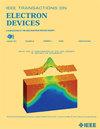整体I/ o finet中总电离剂量效应与热载子降解的相互作用
IF 3.2
2区 工程技术
Q2 ENGINEERING, ELECTRICAL & ELECTRONIC
引用次数: 0
摘要
本文研究了I/O-FIN场效应晶体管(finfet)中总电离剂量(TID)效应和热载流子注入(HCI)降解的相互作用。辐射后应力(SPR)结果表明,辐照后器件的HCI退化程度大于未辐照器件,且辐照后器件在极短时间内受HCI应力恢复迅速。随着应力时间的增加,TID对HCI的影响减小,辐照后的断态泄漏电流不能恢复到器件的初始值。在HCI过程中,电子注入浅沟隔离(STI)是辐照后参数恢复的原因。而辐射后应力(RPS)的实验结果表明,HCI对TID没有明显的影响,因为在TID之前HCI期间没有电子注入STI区域。HCI偏置下的辐照实验表明,这两种效应的共同作用导致了器件特性的变化。揭示了TID与HCI相互作用的机制。本文章由计算机程序翻译,如有差异,请以英文原文为准。
Interaction of Total Ionizing Dose Effect and Hot Carrier Degradation in Bulk I/O-FinFETs
In this article, the interaction of total ionizing dose (TID) effect and hot carrier injection (HCI) degradation in bulk I/O-FIN field-effect transistors (FinFETs) is investigated. The results for stress post radiation (SPR) show that the HCI degradation of irradiated devices is greater than that of unirradiated, and the irradiated devices undergo rapid recovery by HCI stress for a very short time. With the increase of stress time, the influence of TID on HCI decreases and the off-state leakage current after irradiation does not recover to the initial value of the device. The electrons injection into the shallow trench isolation (STI) during HCI is suggested as the reason for parameters recovery after irradiation. While the experiment results of radiation post stress (RPS) show that there is no obvious influence of HCI on TID, since there is no electrons injection into STI region during HCI before TID. The irradiation experiment under HCI bias shows that the combination of these two effects causes the change of device characteristics. The mechanism of interaction between TID and HCI is revealed.
求助全文
通过发布文献求助,成功后即可免费获取论文全文。
去求助
来源期刊

IEEE Transactions on Electron Devices
工程技术-工程:电子与电气
CiteScore
5.80
自引率
16.10%
发文量
937
审稿时长
3.8 months
期刊介绍:
IEEE Transactions on Electron Devices publishes original and significant contributions relating to the theory, modeling, design, performance and reliability of electron and ion integrated circuit devices and interconnects, involving insulators, metals, organic materials, micro-plasmas, semiconductors, quantum-effect structures, vacuum devices, and emerging materials with applications in bioelectronics, biomedical electronics, computation, communications, displays, microelectromechanics, imaging, micro-actuators, nanoelectronics, optoelectronics, photovoltaics, power ICs and micro-sensors. Tutorial and review papers on these subjects are also published and occasional special issues appear to present a collection of papers which treat particular areas in more depth and breadth.
 求助内容:
求助内容: 应助结果提醒方式:
应助结果提醒方式:


